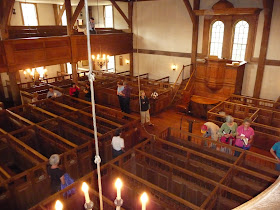 |
Allan Breed Munroe
(1900 - 1962) |
The Century Chest was a time capsule assembled in 1902 with instructions for it to be opened on June 16, 2002. It contained over 200 photographs and letters from the people of Peabody in 1902. These items are now part of the collections of the Peabody Historical Society.
One of the photos found in the time capsule is this one of a small boy, labeled "Allan Greed Monroe, b. 3/1/19—son of Fred and Clara B. Monroe". On the reverse it reads “Looks like his mother!”
It is actually a photo of Allan Breed Munroe, son of William Frederick Munroe and his wife, Clara Bailey (Mansfield). He was the fifth of their nine children! Clara’s mother was Rebecca Stacey Breed. It is an obvious transcription error, also the family name was always spelled Munroe with a “U”. Our common ancestor was Luther Simonds Munroe, born on 10 May 1805 in Danvers, Massachusetts, and died 23 December 1851. He was my 3x great grandfather and Allan’s great grandfather.
Allan would have been my second cousin, twice removed. He married Marjorie Green on 29 June 1929, and he died on 24 Sep 1962. He is one of those long list of George Peabody Merit Medal Scholarship winners I discussed in a post last year. He won his medal in 1917. (See this link for a story about some family members who have wond the George Peabody Merit Medal Scholarship
http://nutfieldgenealogy.blogspot.com/2010/01/george-peabody-merit-scholarship-medals.html )
According to the
Municipal History of Essex County, Massachusetts, Volume 3, by Benjamin F. Arrington, page 138 “…he entered the United States service in March 1918, and was honorably discharged in September, 1919. He was in training at the United States Radio Station at Cambridge, Massachusetts, prior to entering the service, being in the navy. He crossed the ocean three times and saw active service. Since the war he attended Eastern Radio Institute at Boston, Massachusetts, as a student, is now a radio operator, first class, and has again crossed the ocean three times.”
The Century Chest not only contained letters and photographs from citizens, it also contained papers placed in the chest by the 1902 librarian of the Peabody Institute, Lyman P. Osborn. The date the chest was to be opened in 2002 was the 150th Anniversary of the Peabody Institute Library.
After the Century Chest was opened in 2002, a second chest was sealed and stored at the Peabody Historical Society in 2008. It was full of new items, including photo diaries created by Peabody High School students, letters and other items.
Genealogy:
Generation 1. William Munroe, born about 1625 near Inverness, Scotland, died 27 January 1718 in Lexington, Massachusetts; married in 1665 to Martha George, daughter of John George and Elizabeth, born about 1636 in Charlestown, Massachusetts, died about 1672 in Lexington. William married also to Mary Ball in 1672 and Elizabeth Johnson in 1693.
Generation 2. George Munroe, born about 1672 in Lexington, died 17 January 1747 in Lexington; married to Sarah Mooer, daughter of Jonathan Mooer and Constance Langthorne, born about 1677 in Newbury, Massachusetts, died 4 December 1752 in Lexington.
Generation 3. Andrew Munroe, born about 4 June 1718 in Lexington, died 16 September 1766 in Lexington; married on 26 May 1763 to Lucy Mixer, daughter of Joseph Mixer and Mary Ball, born 21 November 1727 in Shrewsbury, Massachusetts, died 3 September 1783 in Burlington or Woburn, Massachusetts.
Generation 4. Andrew Munroe, born 31 March 1764 in Lexington, died 7 August 1836 in Danvers; married on 22 March 1785 in Burlington, Massachusetts to Ruth Simonds, daughter of Caleb Simonds and Susanna Converse, born 13 April 1763 in Woburn, died 29 January 1840 in Danvers.
Generation 5. Luther Simonds Munroe, born 10 May 1805 in Danvers, Massachusetts, died on 23 December 1851 in Danvers; married on 3 Sept 1826 in Reading, Massachusetts to Olive Flint, daughter of John Flint and Phebe Flint, born 27 Jul 1805 in Reading, died 26 November 1875 in Peabody. Six children. Luther and Olive were my 3x Great Grandparents, and I am descended from their daughter Phebe Cross Munroe (1830 - 1895) who married Robert Wilkinson (1830 - 1874).
Generation 6. William Calvin Munroe, born 21 December 1833 in Salem, Massachusetts, died 10 August 1891 in Salem; married on 20 November 1859 in Danvers to Adeline Bradley Jones, daughter of Justus Jones and Sphronia Wood, born about 23 February 1835 in Hampstead, New Hampshire, died on 23 April 1864.
Generation 7. William Frederick Munroe, born 31 March 1864 in Peabody, died 10 June 1912 in Peabody, married on 2 June 1892 in Salem to Clara Bailey Mansfield, born 14 September 1868 in Wakefield, Massachusetts, died 25 March 1939 in Peabody. Nine children.
Generation 8. Allan Breed Munroe, born 1 March 1900 in Peabody, died on 24 September 1962; married on 29 June 1929 to Marjorie Green, born 14 October 1899, died 10 April 1961.
------------------
For the truly curious:
A post from the Peabody Historical Society blog showing a snowstorm in the winter of 1901-1902. These photographs were found in the Century Chest
http://peabodyhistorical.wordpress.com/2010/12/29/here-we-snow-again/
The link to the photo gallery of the items found in the Century Chest at the Peabody, Mass. Archives website
http://www.peabodymassarchives.com/galleries/centurychest.html. This is where the photo of little Allan Munroe was found.
In the book
Then & Now Peabody, by William R. Power, Acadia Publishing, 2008, there are several examples of photos found in the Peabody Century Chest. Mr. Power has taken old photos and new views in Peabody of the same scene to display side by side. This book is available for view online at Google Books.
---------------------
Copyright 2011, Heather Wilkinson Rojo





























